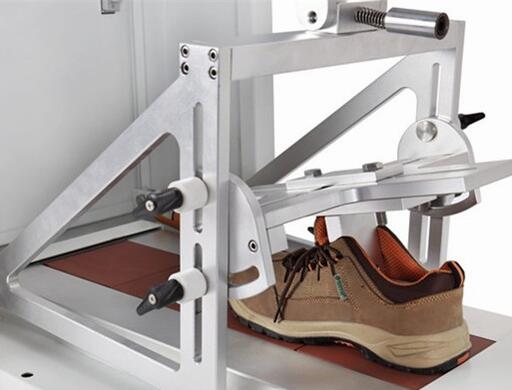
NewsInformation Center
How do you test slip resistance for shoes?
2023/10/12
Shoe slip resistance test is an important step to ensure that the shoes provide good grip in various ground conditions. To test the slip resistance of a shoe, the following steps can be taken:
1. Material Preparation:
- A pair of shoes to be tested is required.
- Anti-slip test equipment, e.g. moisture meter, friction tester, etc.
- Different surface materials, e.g. ceramic tiles, wooden floors, artificial grass, etc.
- Materials for wet and slippery conditions, e.g. water, oil, etc.
2. Pre-preparation:
- Clean soles: Make sure the soles are clean and free from dust or other substances.
- Measurement of humidity: Measure the humidity of each test surface using a humidity measuring instrument.
3. Friction test:
- Place the shoes to be tested on the test bench.
- Using the friction test instrument, the soles of the shoes are brought into contact with different surface materials.
- During the test, the test parameters can be adjusted as needed, such as the force applied, the test time, etc. The test results are recorded for each surface material during the test.
- During the test, the friction coefficient of each surface material is recorded to evaluate the anti-slip performance of the shoes.
4. Wet slip test:
- Add water or oil to the surface material to be tested to simulate wet slippery conditions.
- Place the shoes to be tested on the test bench.
- Using the friction test instrument, the sole of the shoe is brought into contact with the slippery surface material.
- The test parameters, such as force applied, test time, etc., can be adjusted as needed during the test.
- The coefficient of friction of each surface material is recorded during the test to assess the slip resistance of the shoes under slippery conditions.
5. Statistics and analysis of results:
- Calculate the average coefficient of friction of each surface material based on the data from the friction test and wet slip test.
- Compare the friction coefficients of different shoes on different surface materials to judge the advantages and disadvantages of their anti-slip performance.
- Analyse the test results to find out the reasons for the difference in anti-slip performance of different shoes.
6. Other considerations:
- Other factors can be considered in the testing process, such as the material of the sole, pattern design and so on.
- Comparative tests of different sole materials can be carried out to evaluate their anti-slip performance.
- Different pattern designs can be compared to assess their effects on friction performance.
In conclusion, to test the slip resistance of shoes, it is necessary to use special Shoe slip resistance test equipment and surface materials to evaluate the slip resistance of shoes through friction test and wet slip test. At the same time, factors such as sole material and pattern design also need to be considered in order to comprehensively assess the slip resistance performance of shoes.
Previous: What are the for textile toys safety testing?
N e x t : Fire mask resistance to high-speed particle impact testing machine




